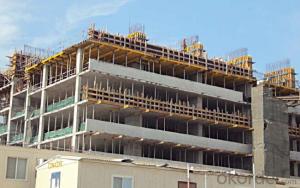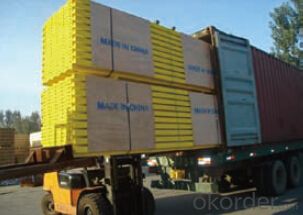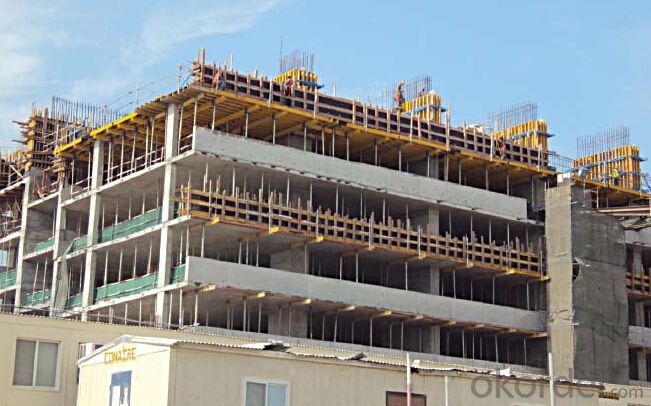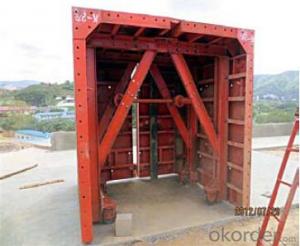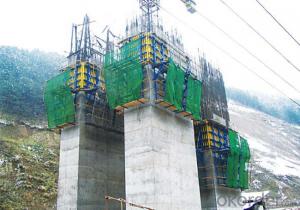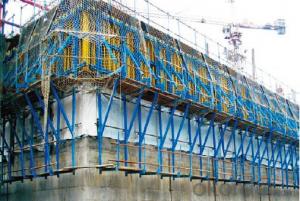Timber-beam Formwork and H20 for formwork and scaffolding system
- Loading Port:
- Tianjin
- Payment Terms:
- TT OR LC
- Min Order Qty:
- 50 m²
- Supply Capability:
- 1000 m²/month
OKorder Service Pledge
OKorder Financial Service
You Might Also Like
Characteristics:
◆ Standardized production lines.
Supply capability: 3000m/day, Lmax = 6600mm.
◆ Finger jointing of the flange and web, the strength of timber beam is highly improved.
Max. shearing force failure load:40KN
◆ Well treated to prevent from water penetration or erosion, so the service life maximally
extended.
Normally, CNBM timber beam H20 can be used for 4 to 5 years, the exact using time would
depend on maintenance & storage.
◆ Robust caps at the end of the girders protect against damages.
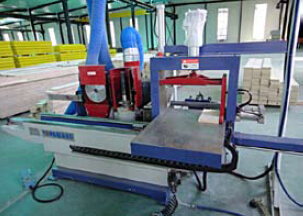
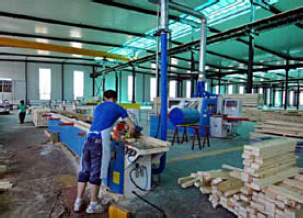
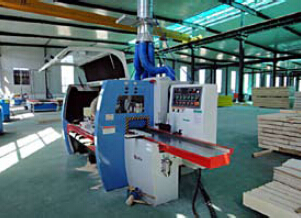
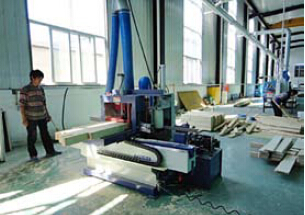
- Q: What are the different types of accessories used with steel formwork?
- There are various types of accessories that are commonly used with steel formwork to enhance its functionality and effectiveness in construction projects. Some of the different types of accessories used with steel formwork include: 1. Formwork Wedges: These are small wedges made of steel or plastic that are used to secure the formwork panels together. They help in maintaining the accurate alignment and stability of the formwork system during concrete pouring. 2. Formwork Clamps: Clamps are used to hold the formwork panels in place and prevent any movement or displacement during the pouring and curing of concrete. They are typically made of steel and are available in different sizes and designs to suit various formwork requirements. 3. Formwork Ties: Ties are used to connect the formwork panels and provide structural stability to the formwork system. They can be either steel or plastic and are available in different lengths and types, such as snap ties, wedge ties, and loop ties. 4. Formwork Braces: Braces are used to reinforce and strengthen the formwork system. They are typically made of steel and are used to support the formwork panels and prevent any bending or deformation during the concrete pouring process. 5. Formwork Hangers: Hangers are used to suspend the formwork panels at the desired height and provide support. They are typically made of steel and are adjustable to accommodate different formwork heights and configurations. 6. Formwork Spacers: Spacers are used to maintain the desired spacing between the formwork panels and ensure uniformity in the thickness of the concrete walls or slabs. They are typically made of plastic or steel and are available in various sizes and shapes. 7. Formwork Release Agents: Release agents are used to prevent the adhesion of concrete to the formwork surface. They are applied to the formwork panels before the concrete is poured, allowing for easy removal of the formwork once the concrete has cured. Overall, these accessories play a crucial role in ensuring the stability, alignment, and functionality of steel formwork systems. They contribute to the efficiency and quality of construction projects by providing reliable support and reinforcement to the formwork during the concrete pouring process.
- Q: How does steel formwork improve the quality of concrete structures?
- Steel formwork is widely used in the construction industry due to its numerous advantages, including its ability to significantly improve the quality of concrete structures. Here are some ways in which steel formwork enhances the quality of concrete structures: 1. Better Form Stability: Steel formwork provides superior form stability compared to traditional wooden formwork. It is more rigid and less prone to warping or distortion, ensuring that the concrete is poured into a precise and consistent shape. This results in straighter walls, smoother surfaces, and overall better structural integrity. 2. Increased Durability: Steel formwork is highly durable and can withstand the harsh conditions of the construction site. It does not rot, decay, or get damaged easily, unlike wooden formwork. Its long lifespan ensures that it can be reused multiple times, reducing costs and waste. This durability translates into stronger and longer-lasting concrete structures. 3. Accurate Dimensions: Steel formwork is manufactured with high precision, allowing for accurate and consistent dimensions in the concrete structures. It helps in achieving the desired shape, size, and alignment of the elements. This accuracy is crucial in ensuring that the structure meets the required specifications and architectural designs, resulting in a high-quality finished product. 4. Improved Surface Finish: Steel formwork provides a smooth and even surface finish to the concrete structures. The steel panels are designed to minimize surface imperfections and prevent leakage of the concrete mixture. This results in a visually appealing structure with a uniform finish, reducing the need for additional plastering or finishing work. 5. Enhanced Safety: Steel formwork offers increased safety during the construction process. Its sturdy and rigid nature provides a stable platform for workers to pour and work with the concrete. The risk of accidents, such as formwork failure or collapse, is significantly reduced with steel formwork, ensuring the safety of workers and the integrity of the structure. Overall, the use of steel formwork in concrete construction brings several benefits that contribute to the improvement of the quality of the structures. With its form stability, durability, accurate dimensions, improved surface finish, and enhanced safety, steel formwork plays a crucial role in ensuring the integrity, aesthetics, and longevity of concrete structures.
- Q: What are the common quality control measures for steel formwork systems?
- Some common quality control measures for steel formwork systems include conducting regular inspections of the formwork components for any signs of damage or wear, verifying the accuracy of dimensions and alignments, ensuring proper installation and alignment of formwork components, conducting load tests to ensure the formwork system can withstand the required loads, and monitoring the concrete pouring process to ensure proper placement and consolidation. Additionally, adherence to relevant industry standards and guidelines, as well as proper documentation and record-keeping, are also important quality control measures for steel formwork systems.
- Q: Can steel formwork be used in educational or institutional construction projects?
- Yes, steel formwork can be used in educational or institutional construction projects. Steel formwork is a versatile and durable solution that can provide many benefits in such projects. Firstly, steel formwork offers high strength and stability, which is essential in constructing large and complex structures typically found in educational or institutional buildings. It can withstand heavy loads and provides a secure framework for concrete placement. This is particularly important in projects where there are multiple levels or large spans. Secondly, steel formwork is reusable, which can significantly reduce construction costs and waste. Once the concrete has set, the steel formwork can be removed and used again in another section of the building or in future projects. This not only saves money but also contributes to sustainability efforts by minimizing the need for new materials. Thirdly, steel formwork allows for precise and accurate construction. It can be easily adjusted and modified to accommodate various architectural and design requirements. This is especially crucial in educational or institutional buildings where specific layouts and dimensions are needed to meet the functional needs of classrooms, laboratories, offices, or other facilities. Moreover, steel formwork enables faster construction compared to traditional timber formwork. Its lightweight nature and ease of assembly make it more efficient, reducing construction time and enabling earlier project completion. This is particularly beneficial in educational or institutional projects where there might be tight deadlines due to academic schedules or other time constraints. Finally, steel formwork offers enhanced safety measures during construction. Its robust structure ensures stability, reducing the risk of accidents or structural failures. Additionally, steel formwork can provide a safer working environment for construction workers, as it eliminates the need for excessive scaffolding or temporary supports. In conclusion, steel formwork is a suitable choice for educational or institutional construction projects. It provides strength, durability, reusability, precision, efficiency, and safety, making it a highly beneficial solution for constructing complex and functional buildings.
- Q: What are the different types of steel formwork supports?
- There are several different types of steel formwork supports that are commonly used in construction projects. Some of the main types include: 1. Adjustable Steel Props: These are vertical supports that can be adjusted to desired heights. They are made of steel tubes with an adjustable inner and outer tube, allowing for easy height adjustment. Adjustable steel props are commonly used to support horizontal formwork or scaffolding systems. 2. Soldier Formwork System: This type of steel formwork support consists of vertical steel members known as soldiers that are spaced at regular intervals along the formwork. Soldiers are designed to resist the lateral pressure of wet concrete and provide support to the formwork panels. 3. Trench Struts: Trench struts are used to support and stabilize formwork in trenches or excavations. They consist of steel tubes with adjustable length and are typically used in conjunction with steel walers or beams to create a sturdy framework for the formwork. 4. H-Frame Systems: H-frame systems are commonly used for vertical formwork supports. They consist of steel frames in the shape of an "H" that are connected together to create a stable structure. H-frame systems are often used for supporting vertical formwork panels or as a framework for climbing formwork systems. 5. Steel Waler: A steel waler is a horizontal member used to support the formwork panels. It is typically made of steel channels or beams and is used in conjunction with vertical supports like adjustable steel props or trench struts. These are just a few examples of the different types of steel formwork supports that are commonly used in construction. The choice of support system depends on the specific requirements of the project, such as the formwork design, load capacity, and desired adjustability.
- Q: How does steel formwork compare to aluminum formwork?
- In construction projects, two popular types of formwork systems are utilized: steel formwork and aluminum formwork. While both options have their pros and cons, several notable distinctions set them apart. Strength and Durability: Steel formwork boasts exceptional strength and durability, making it ideal for heavy-duty construction projects. It can withstand high load capacities and is resistant to deformation. Conversely, aluminum formwork, although lighter, lacks the same level of strength as steel. It is more suitable for smaller-scale projects that do not require heavy loads. Weight and Handling: Steel formwork is significantly heavier than aluminum formwork. This disparity can make transportation and handling more challenging, demanding more labor and machinery. On the other hand, aluminum formwork, being lightweight, is easier to handle and transport, minimizing the need for additional resources. Cost: Steel formwork tends to be pricier than aluminum formwork due to its superior strength and durability. However, steel formwork has a longer lifespan and can be reused multiple times, potentially making it more cost-effective in the long run. In contrast, aluminum formwork is cheaper initially but may necessitate more frequent replacement due to its lower durability. Versatility and Adaptability: Steel formwork can be tailored to fit various shapes and sizes, providing greater design flexibility. It is highly adaptable, allowing for on-site modifications if necessary. Conversely, aluminum formwork is less versatile and typically comes in standard sizes. Consequently, more planning and precision are required during the design phase. Surface Finish: Steel formwork typically yields a smoother and more uniform surface finish compared to aluminum formwork. This is crucial for projects where the appearance of concrete elements is of utmost importance, such as architectural structures. Environmental Impact: Aluminum formwork is considered more environmentally friendly than steel formwork. Aluminum can be recycled and reused more easily, thus reducing its carbon footprint. Conversely, steel requires more energy and resources for production and recycling. In conclusion, steel formwork and aluminum formwork each possess distinct advantages and disadvantages. Steel formwork excels in strength, durability, and surface finishes but is heavier, costlier, and less environmentally friendly. On the other hand, aluminum formwork is lighter, cost-effective, and easier to handle but lacks equal strength and durability. Ultimately, the choice between the two depends on the specific requirements of the construction project and the priorities of the contractor or builder.
- Q: How does steel formwork handle concrete finishing and curing agents?
- Steel formwork is a highly durable and versatile material that is specifically designed to handle the concrete finishing and curing process. Due to its strength and rigidity, steel formwork provides a stable structure that ensures the concrete is poured and cured in a controlled manner. During the concrete finishing stage, steel formwork allows for the smooth and even application of various finishing agents such as troweling, brushing, or spraying. The smooth surface of steel formwork allows for the easy application and manipulation of these agents, resulting in a uniform and aesthetically pleasing finish. Additionally, steel formwork is resistant to chemical reactions with concrete curing agents. Concrete curing agents are applied to the surface of freshly poured concrete to enhance its strength, durability, and appearance. These agents can include sealers, curing compounds, or coatings. Steel formwork does not chemically react with these substances, ensuring that they can be applied and absorbed by the concrete without any negative effects on the formwork material. Moreover, steel formwork is non-absorbent, meaning it does not absorb any moisture from the curing agents or the concrete itself. This characteristic is crucial during the curing process as it allows the concrete to retain its moisture content, ensuring proper hydration and strength development. The non-absorbent nature of steel formwork also prevents any potential damage or degradation that could occur if the formwork material were to absorb moisture and expand or corrode. In summary, steel formwork is an ideal material for handling concrete finishing and curing agents due to its strength, rigidity, non-reactive nature, and non-absorbent properties. It provides a stable structure for the application of finishing agents, while also allowing for proper curing and moisture retention in the concrete.
- Q: How does steel formwork handle different concrete slump flow measurements?
- Steel formwork is highly durable and rigid, making it suitable for handling various concrete slump flow measurements. Its robust structure provides excellent support and stability, ensuring that the concrete maintains its desired shape and form during the pouring and curing process. Additionally, steel formwork can be easily adjusted and modified to accommodate different slump flow measurements, allowing for precise and efficient construction.
- Q: What are the factors to consider when selecting steel formwork?
- To choose the right steel formwork, one must take into account various factors. Firstly, the strength and durability of the formwork are crucial. It should be able to bear the weight of the concrete and withstand the forces applied during pouring and curing. Additionally, it should maintain its structural integrity after multiple uses. Secondly, flexibility and adaptability are important considerations. The formwork should be easily adjustable and capable of accommodating different shapes and sizes of concrete elements. This is especially vital for complex or irregular structures. Next, the ease of assembly and dismantling plays a significant role. The formwork system should be quick and straightforward to put together and take apart, as this affects the overall construction timeline. The use of standardized components and a simple connection system can expedite this process. Furthermore, the surface finish of the concrete is a key factor, particularly for architectural projects. The steel formwork should provide a smooth and flawless surface without any visible marks or imperfections, ensuring a high-quality end result. Considering cost-effectiveness is also essential. The total cost of the formwork system, including the initial investment, maintenance, and reusability, should be taken into account. Although steel formwork may have a higher upfront cost, its durability and reusability make it a cost-effective choice in the long run. Safety is of paramount importance. The design and manufacture of the steel formwork should incorporate safety features such as non-slip surfaces, secure connections, and sufficient bracing to prevent accidents or collapses. Additionally, the environmental impact of the formwork material should be considered. Steel formwork is often considered more environmentally friendly than traditional timber formwork due to its ability to be reused and recycled. By considering these factors, construction professionals can make an informed decision when selecting steel formwork that meets their project requirements and delivers optimal results.
- Q: Can steel formwork be custom-made?
- Indeed, the option of customizing steel formwork exists. Steel, being an adaptable material, can be effortlessly molded and joined together through welding to produce formwork tailored to suit specific project demands. In situations where conventional formwork systems may prove inadequate due to distinctive design components or intricate geometries, the utilization of custom-made steel formwork is frequently favored in construction endeavors. The customization of steel formwork allows construction firms to ensure a perfect fit, thereby facilitating efficient and precise pouring of concrete, minimizing waste, and preserving time and financial resources. Moreover, the durability and reusability of custom-made steel formwork offer enduring advantages for numerous construction projects in the long run.
Send your message to us
Timber-beam Formwork and H20 for formwork and scaffolding system
- Loading Port:
- Tianjin
- Payment Terms:
- TT OR LC
- Min Order Qty:
- 50 m²
- Supply Capability:
- 1000 m²/month
OKorder Service Pledge
OKorder Financial Service
Similar products
Hot products
Hot Searches
Related keywords

